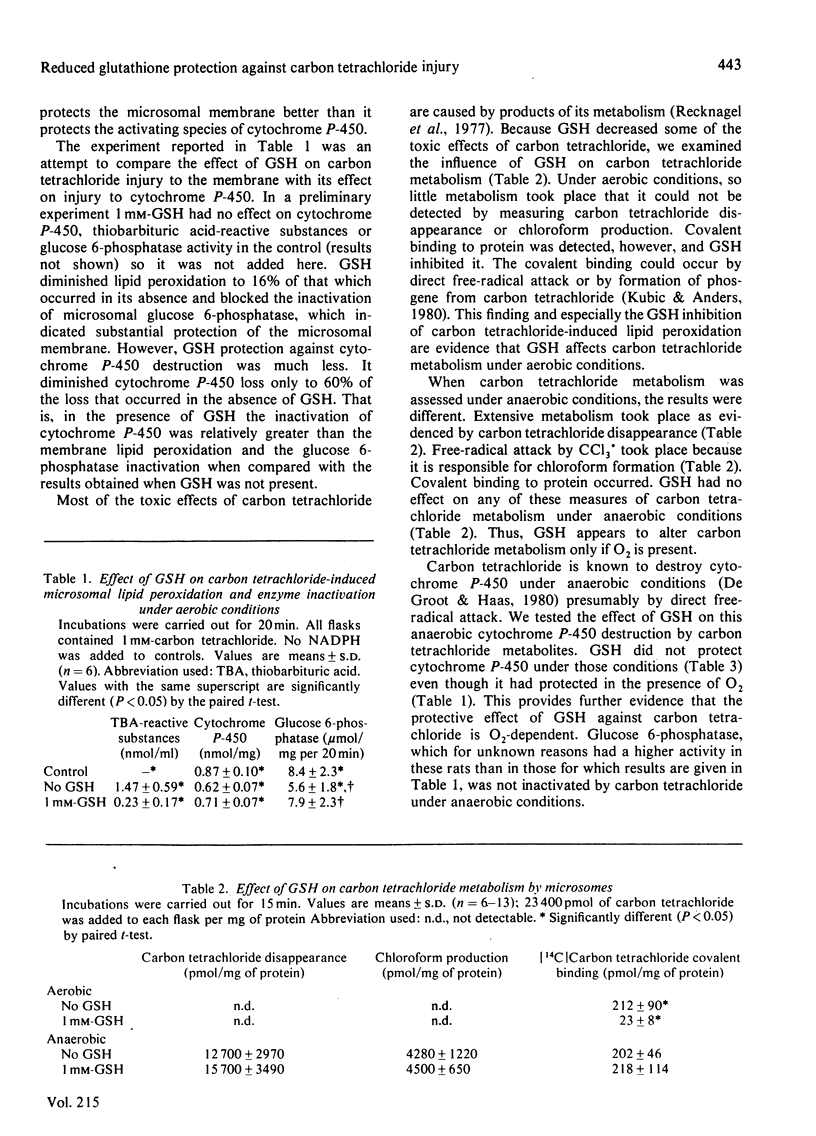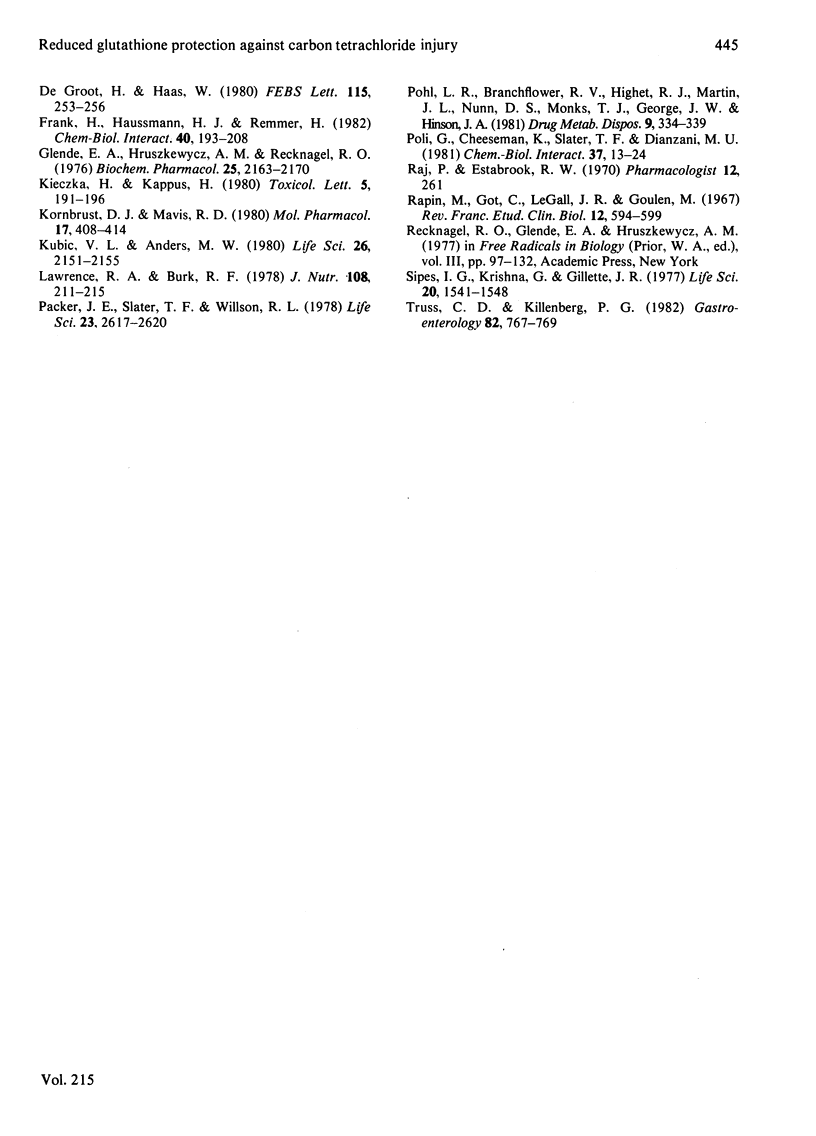Abstract
Rat liver microsomal membranes contain a reduced-glutathione-dependent protein(s) that inhibits lipid peroxidation in the ascorbate/iron microsomal lipid peroxidation system. It appears to exert its protective effect by scavenging free radicals. The present work was carried out to assess the effect of this reduced-glutathione-dependent mechanism on carbon tetrachloride-induced microsomal injury and on carbon tetrachloride metabolism because they are known to involve free radicals. Rat liver microsomes were incubated at 37 degrees C with NADPH, EDTA and carbon tetrachloride. The addition of 1 mM-reduced glutathione (GSH) markedly inhibited lipid peroxidation and glucose 6-phosphatase inactivation and, to a lesser extent, inhibited cytochrome P-450 destruction. GSH also inhibited covalent binding of [14C]carbon tetrachloride-derived 14C to microsomal protein. These results indicate that a GSH-dependent mechanism functions to protect the microsomal membrane against free-radical injury in the carbon tetrachloride system as well as in the iron-based systems. Under anaerobic conditions, GSH had no effect on chloroform formation, carbon tetrachloride-induced destruction of cytochrome P-450 or covalent binding of [14C]carbon tetrachloride-derived 14C to microsomal protein. Thus, the GSH protective mechanism appears to be O2-dependent. This suggests that it may be specific for O2-based free radicals. This O2-dependent GSH protective mechanism may partly underlie the observed protection of hyperbaric O2 against carbon tetrachloride-induced lipid peroxidation and hepatotoxicity.
Full text
PDF




Selected References
These references are in PubMed. This may not be the complete list of references from this article.
- Burk R. F. Glutathione-dependent protection by rat liver microsomal protein against lipid peroxidation. Biochim Biophys Acta. 1983 May 4;757(1):21–28. doi: 10.1016/0304-4165(83)90148-4. [DOI] [PubMed] [Google Scholar]
- Burk R. F. Protection by GSH against lipid peroxidation induced by ascorbate and iron in rat liver microsomes. Biochem Pharmacol. 1982 Feb 15;31(4):601–602. doi: 10.1016/0006-2952(82)90168-x. [DOI] [PubMed] [Google Scholar]
- Christophersen B. O. The inhibitory effect of reduced glutathione on the lipid peroxidation of the microsomal fraction and mitochondria. Biochem J. 1968 Jan;106(2):515–522. doi: 10.1042/bj1060515. [DOI] [PMC free article] [PubMed] [Google Scholar]
- Frank H., Haussmann H. J., Remmer H. Metabolic activation of carbon tetrachloride: induction of cytochrome P-450 with phenobarbital or 3-methylcholanthrene and its effect on covalent binding. Chem Biol Interact. 1982 Jun;40(2):193–208. doi: 10.1016/0009-2797(82)90101-6. [DOI] [PubMed] [Google Scholar]
- Glende E. A., Jr, Hruszkewycz A. M., Recknagel R. O. Critical role of lipid peroxidation in carbon tetrachloride-induced loss of aminopyrine demethylase, cytochrome P-450 and glucose 6-phosphatase. Biochem Pharmacol. 1976 Oct 1;25(19):2163–2170. doi: 10.1016/0006-2952(76)90128-3. [DOI] [PubMed] [Google Scholar]
- Kieczka H., Kappus H. Oxygen dependence of CCl4-induced lipid peroxidation in vitro and in vivo. Toxicol Lett. 1980 Mar;5(3-4):191–196. doi: 10.1016/0378-4274(80)90058-2. [DOI] [PubMed] [Google Scholar]
- Kornbrust D. J., Mavis R. D. Microsomal lipid peroxidation. II. Stimulation by carbon tetrachloride. Mol Pharmacol. 1980 May;17(3):408–414. [PubMed] [Google Scholar]
- Kubic V. L., Anders M. W. Metabolism of carbon tetrachloride to phosgene. Life Sci. 1980 Jun 23;26(25):2151–2155. doi: 10.1016/0024-3205(80)90602-5. [DOI] [PubMed] [Google Scholar]
- Lawrence R. A., Burk R. F. Species, tissue and subcellular distribution of non Se-dependent glutathione peroxidase activity. J Nutr. 1978 Feb;108(2):211–215. doi: 10.1093/jn/108.2.211. [DOI] [PubMed] [Google Scholar]
- Packer J. E., Slater T. F., Willson R. L. Reactions of the carbon tetrachloride-related peroxy free radical (CC13O.2) with amino acids: pulse radiolysis evidence. Life Sci. 1978 Dec 25;23(26):2617–2620. doi: 10.1016/0024-3205(78)90378-8. [DOI] [PubMed] [Google Scholar]
- Pohl L. R., Branchflower R. V., Highet R. J., Martin J. L., Nunn D. S., Monks T. J., George J. W., Hinson J. A. The formation of diglutathionyl dithiocarbonate as a metabolite of chloroform, bromotrichloromethane, and carbon tetrachloride. Drug Metab Dispos. 1981 Jul-Aug;9(4):334–339. [PubMed] [Google Scholar]
- Rapin M., Got C., Le Gall J. R., Goulon M. Effet de l'oxygène hyperbare sur la toxicité hépatique du tétrachlorure de carbone chez le rat. Rev Fr Etud Clin Biol. 1967 Jun-Jul;12(6):594–599. [PubMed] [Google Scholar]
- Sipes I. G., Krishna G., Gillette J. R. Bioactivation of carbon tetrachloride, chloroform and bromotrichloromethane: role of cytochrome P-450. Life Sci. 1977 May 1;20(9):1541–1548. doi: 10.1016/0024-3205(77)90446-5. [DOI] [PubMed] [Google Scholar]
- Truss C. D., Killenberg P. G. Treatment of carbon tetrachloride poisoning with hyperbaric oxygen. Gastroenterology. 1982 Apr;82(4):767–769. [PubMed] [Google Scholar]
- de Groot H., Haas W. O2-independent damage of cytochrome P450 by CCl4-metabolites in hepatic microsomes. FEBS Lett. 1980 Jun 30;115(2):253–256. doi: 10.1016/0014-5793(80)81180-x. [DOI] [PubMed] [Google Scholar]


